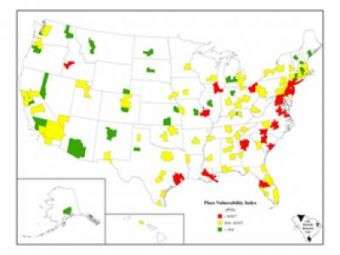Researchers identify cities at risk for terrorism

A University of Arizona researcher has created a new system to dramatically show American cities their relative level of vulnerability to bioterrorism.
Walter W. Piegorsch, an expert on environmental risk, has placed 132 major cities – from Albany, N.Y., to Youngstown, Ohio – on a color-coded map that identifies their level of risk based on factors including critical industries, ports, railroads, population, natural environment and other factors.
Piegorsch is the director of a new UA graduate program in interdisciplinary statistics and a professor of mathematics in the College of Science, as well as a member of the UA’s BIO5 Institute.
The map marks high-risk areas as red (for example, Houston and, surprisingly, Boise, ID), midrange risk as yellow (San Francisco) and lower risk as green (Tucson). The map shows a wide swath of highest-risk urban areas running from New York down through the Southeast and into Texas. Boise is the only high-risk urban area that lies outside the swath.
The model employs what risk experts call a benchmark vulnerability metric, which shows risk managers each city’s level of risk for urban terrorism.
Piegorsch says terrorism vulnerability involves three dimensions of risk – social aspects, natural hazards and construction of the city and its infrastructure.
He concludes that the allocation of funds for preparedness and response to terrorism should take into account these factors of vulnerability.
“Our capacity to adequately prepare for and respond to these vulnerabilities varies widely across the country, especially in urban areas,” he wrote in an article about the research. Piegorsch argues that “any one-size-fits-all strategy” of resource allocation and training ignores the reality of the geographic differences identified in his study. Such failures, he says, would “limit urban areas’ abilities to prepare for and respond to terrorist events.”
The research, funded by the U.S. Department of Homeland Security, was published in a recent issue of Risk Analysis, a journal published by the Society for Risk Analysis.
Source: University of Arizona





















